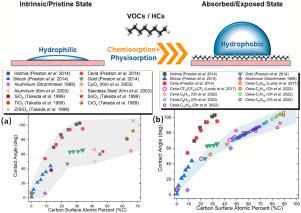当前位置:
X-MOL 学术
›
Adv. Colloid Interface Sci.
›
论文详情
Our official English website, www.x-mol.net, welcomes your feedback! (Note: you will need to create a separate account there.)
Ambient-mediated wetting on smooth surfaces
Advances in Colloid and Interface Science ( IF 15.6 ) Pub Date : 2023-12-28 , DOI: 10.1016/j.cis.2023.103075 Daniel Orejon , Junho Oh , Daniel J. Preston , Xiao Yan , Soumyadip Sett , Yasuyuki Takata , Nenad Miljkovic , Khellil Sefiane
Advances in Colloid and Interface Science ( IF 15.6 ) Pub Date : 2023-12-28 , DOI: 10.1016/j.cis.2023.103075 Daniel Orejon , Junho Oh , Daniel J. Preston , Xiao Yan , Soumyadip Sett , Yasuyuki Takata , Nenad Miljkovic , Khellil Sefiane

|
A consensus was built in the first half of the 20th century, which was further debated more than 3 decades ago, that the wettability and condensation mechanisms on smooth solid surfaces are modified by the adsorption of organic contaminants present in the environment. Recently, disagreement has formed about this topic once again, as many researchers have overlooked contamination due to its difficulty to eliminate. For example, the intrinsic wettability of rare earth oxides has been reported to be hydrophobic and non-wetting to water. These materials were subsequently shown to display dropwise condensation with steam. Nonetheless, follow on research has demonstrated that the intrinsic wettability of rare earth oxides is hydrophilic and wetting to water, and that a transition to hydrophobicity occurs in a matter of hours-to-days as a consequence of the adsorption of volatile organic compounds from the ambient environment. The adsorption mechanisms, kinetics, and selectivity, of these volatile organic compounds are empirically known to be functions of the substrate material and structure. However, these mechanisms, which govern the surface wettability, remain poorly understood. In this contribution, we introduce current research demonstrating the different intrinsic wettability of metals, rare earth oxides, and other smooth materials, showing that they are intrinsically hydrophilic. Then we provide details on research focusing on the transition from wetting (hydrophilicity) to non-wetting (hydrophobicity) on somooth surfaces due to adsorption of volatile organic compounds. A state-of-the-art figure of merit mapping the wettability of different smooth solid surfaces to ambient exposure as a function of the surface carbon content has also been developed. In addition, we analyse recent works that address these wetting transitions so to shed light on how such processes affect droplet pinning and lateral adhesion. We then conclude with objective perspectives about research on wetting to non-wetting transitions on smooth solid surfaces in an attempt to raise awareness regarding this surface phenomenon within the engineering, interfacial science, and physical chemistry domains.
中文翻译:

光滑表面上环境介导的润湿
20世纪上半叶达成的共识是,光滑固体表面的润湿性和冷凝机制是通过吸附环境中存在的有机污染物而改变的,这一共识在30多年前得到了进一步的争论。最近,关于这个话题再次出现了分歧,因为许多研究人员由于污染难以消除而忽视了它。例如,据报道,稀土氧化物的固有润湿性是疏水性的并且不被水润湿。这些材料随后显示出与蒸汽的滴状冷凝。尽管如此,后续研究表明,稀土氧化物的固有润湿性是亲水性的,对水润湿,并且由于从稀土氧化物中吸附挥发性有机化合物,在几小时到几天内就会发生向疏水性的转变。周围环境。根据经验,这些挥发性有机化合物的吸附机制、动力学和选择性是基材材料和结构的函数。然而,人们对这些控制表面润湿性的机制仍然知之甚少。在这篇文章中,我们介绍了当前的研究,证明金属、稀土氧化物和其他光滑材料具有不同的固有润湿性,表明它们本质上是亲水的。然后,我们提供了有关由于挥发性有机化合物的吸附而导致光滑表面从润湿(亲水性)到不润湿(疏水性)转变的研究的详细信息。还开发了一种最先进的品质因数,将不同光滑固体表面的润湿性与环境暴露作为表面碳含量的函数进行映射。此外,我们分析了最近解决这些润湿转变的工作,以阐明这些过程如何影响液滴钉扎和横向粘附。然后,我们以客观的视角总结了光滑固体表面润湿到不润湿转变的研究,试图提高工程、界面科学和物理化学领域对这种表面现象的认识。
更新日期:2023-12-28
中文翻译:

光滑表面上环境介导的润湿
20世纪上半叶达成的共识是,光滑固体表面的润湿性和冷凝机制是通过吸附环境中存在的有机污染物而改变的,这一共识在30多年前得到了进一步的争论。最近,关于这个话题再次出现了分歧,因为许多研究人员由于污染难以消除而忽视了它。例如,据报道,稀土氧化物的固有润湿性是疏水性的并且不被水润湿。这些材料随后显示出与蒸汽的滴状冷凝。尽管如此,后续研究表明,稀土氧化物的固有润湿性是亲水性的,对水润湿,并且由于从稀土氧化物中吸附挥发性有机化合物,在几小时到几天内就会发生向疏水性的转变。周围环境。根据经验,这些挥发性有机化合物的吸附机制、动力学和选择性是基材材料和结构的函数。然而,人们对这些控制表面润湿性的机制仍然知之甚少。在这篇文章中,我们介绍了当前的研究,证明金属、稀土氧化物和其他光滑材料具有不同的固有润湿性,表明它们本质上是亲水的。然后,我们提供了有关由于挥发性有机化合物的吸附而导致光滑表面从润湿(亲水性)到不润湿(疏水性)转变的研究的详细信息。还开发了一种最先进的品质因数,将不同光滑固体表面的润湿性与环境暴露作为表面碳含量的函数进行映射。此外,我们分析了最近解决这些润湿转变的工作,以阐明这些过程如何影响液滴钉扎和横向粘附。然后,我们以客观的视角总结了光滑固体表面润湿到不润湿转变的研究,试图提高工程、界面科学和物理化学领域对这种表面现象的认识。



























 京公网安备 11010802027423号
京公网安备 11010802027423号